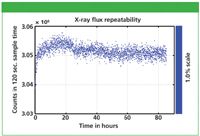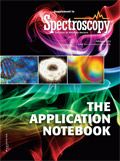Moxtek's ULTRA-LITE X-ray Source
Moxtek's ULTRA-LITE X-ray source is a very small self contained X-ray source (X-ray tube and high voltage power supply) for use in portable X-ray applications, such as the handheld X-ray fluorescence (XRF) spectrometers. This note demonstrates that this X-ray source has a stable and repeatable X-ray flux output over time, which is vital for the precision of the calibrated XRF measurements.
Moxtek's ULTRA-LITE X-ray source is a very small self contained X-ray source (X-ray tube and high voltage power supply) for use in portable X-ray applications, such as the handheld X-ray fluorescence (XRF) spectrometers. This note demonstrates that this X-ray source has a stable and repeatable X-ray flux output over time, which is vital for the precision of the calibrated XRF measurements.
Moxtek's ULTRA-LITE source has a high voltage range of 5–50 kV, an emission current range of 5–200 µA, and comes with an assortment of anode materials including tungsten and silver. The maximum output power on the X-ray tube is 4 Watts. With the X-ray tube running at full power, the source draws approximately 9 Watts. At full power the ULTRA-LITE X-ray source will run for over 3 h on a typical 12 V 2.4 mA-hour batteries. It is very small in size, 25 mm × 46 mm × 148 mm, and weighs only 250 g, making it perfect for handheld and portable instruments.
Two of the key metrics of the X-ray source for XRF applications, and many other applications as well, are X-ray flux and high voltage repeatability. Repeatability means that every time the source is turned on at a particular high voltage and current setting, the high voltage and the X-ray flux stays as constant over time.
Experimental Conditions
In development of the ULTRA-LITE X-ray source we performed a number of characterization tests on multiple units. One key test is a flux repeatability test, in which the source is turned on and off numerous times. For each on/off cycle we capture an image of the focal spot, record the X-ray energy spectra coming off the tube, the energy spectra coming off a secondary XRF target, as well as input and monitor voltages and currents over several hours to days at room temperature.
Results & Conclusions
From these tests we have seen that the ULTRA-LITE source has a very stable and repeatable X-ray flux and high voltage. The flux was measured directly from the source with an X-ray PIN Diode, which measures the flux by counting X-ray photon events. Figure 1 shows the X-ray photon counts collected from an ULTRA-LITE source over 3.5 days of time. The PIN diode also records the energy spectra of the incoming photons, which contains the bremsstrahlung edge from the source. By tracking the bremsstrahlung edge the high voltage stability of the source was tracked over time.

Figure 1: This shows the flux repeatability from one ULTRA-LITE source set at the maximum voltage of 50 kV and 80 µA, the full 4 Watts. The flux is stable to under 0.10% RSD (std/mean) over 3.5 days. The source was turned on for 120 s, then off for 10 s, and cycled on & off 2400 times for this test.
The high voltage of the source does not vary more than ±100 V at 50 (0.2%) kV by measuring the bremsstrahlung edge, and the flux is stable and repeatable within 0.5% RSD or less over the time frame of days. The repeatability of this source will be an asset to any handheld or portable application where excellent flux repeatability is needed, such as XRF.
Moxtek
West 1260 North, Orem, UT 84057
tel. (800) 758-3110
Email: info@moxtek.com
Website: www.moxtek.com

Thermo Fisher Scientists Highlight the Latest Advances in Process Monitoring with Raman Spectroscopy
April 1st 2025In this exclusive Spectroscopy interview, John Richmond and Tom Dearing of Thermo Fisher Scientific discuss the company’s Raman technology and the latest trends for process monitoring across various applications.
A Seamless Trace Elemental Analysis Prescription for Quality Pharmaceuticals
March 31st 2025Quality assurance and quality control (QA/QC) are essential in pharmaceutical manufacturing to ensure compliance with standards like United States Pharmacopoeia <232> and ICH Q3D, as well as FDA regulations. Reliable and user-friendly testing solutions help QA/QC labs deliver precise trace elemental analyses while meeting throughput demands and data security requirements.